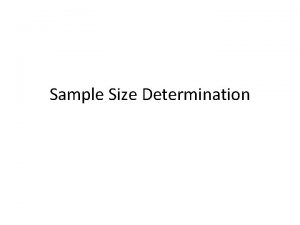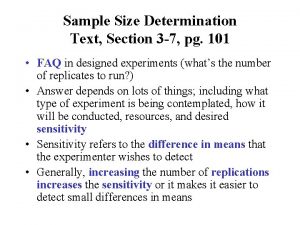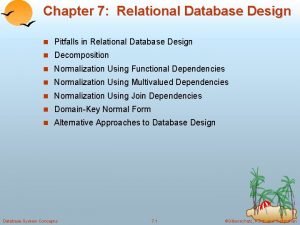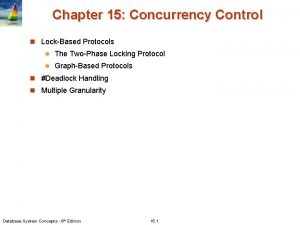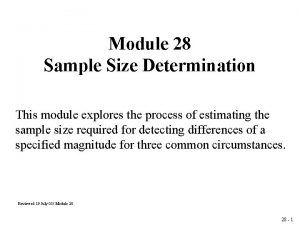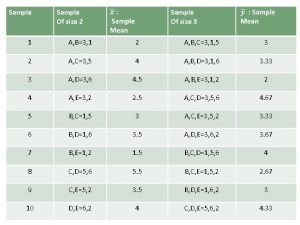MODULE I Introducing Sample Size Determination Pitfalls Sample











- Slides: 11


MODULE I Introducing Sample Size Determination & Pitfalls

Sample Size Determination (SSD) Review SSD finds the appropriate sample size for your study Common metrics are statistical power, interval width or cost SSD seeks to balance ethical and practical issues A standard design requirement for regulatory purposes SSD is crucial to arrive at valid conclusions in a study High incidence of non-replicable results, Type M/S


5 Essential Steps for Sample Size 1 Plan Study 2 Specify Parameters 3 Choose Effect Size Compute Sample Study question, primary outcome, statistical method Significance Level, Standard deviation, ICC, dispersion Expected/targeted difference, ratio or other effect size Sample Size for specified metric such

Overview & Pitfalls at Planning Stage • Fail to prepare, prepare to fail – Design, Design! • SSD is one part of design process • Hypotheses, endpoints, methods • To start can rely on “standard” method • Consider choices effect on power • See “dichotomania”, different methods strengths/weaknesses • Power can also highlight poor choices! Source: S. Senn (2005)

Overview & Pitfalls at Specify Stage • SSD occurs before trial so uncertainty is intrinsic challenge • Will specify multiple parameters • Some Fixed (α), some unknown (σ) • More Parameters, More Assumptions • Justify, if possible, your estimates • Pilot study, previous data, other studies, elicitation, guesswork etc. • Consistency = less problems • Takeaway: More evidence =

Overview & Pitfalls with Effect Size • Differing opinions on meaning • Expected, clinical sig. , standardised • “Minimum value worth detecting” • # of approaches to find value • Mix and match sources/methods • Approach and meaning linked • Do not reverse justify from N! • Also parameterisation options • Takeaway: Think about your ES and set appropriately Source: S. Julious (2017)

Overview & Pitfalls with Sample Size/Power • 80/90% Power standard • 90% gives “optimism” adjustment • 90% = implicit 2 -study adjustment • Some Sample size adjustments • Dropout, Unequal, CRT choices • Easier: N(D) = N/(1 -P(Dropout)) • Harder: Survival, Simulation, MNAR • For fixed sample size, more thought in planning needed

Overview & Pitfalls at Exploration Stage • Biggest Pitfall: Not bothering • Should explore all assumptions • Design, ES, other values, N, power • Should do Sensitivity Analysis • What scenarios to test? (95% CI) • How confident in first N estimate? • Focus where uncertain/large effect • Other approaches can help • Plots, assurance, alternative methods “The method by which the sample size is calculated should be given in the protocol, together with the estimates of any quantities used in the calculations (such as variances, mean values, response rates, event rates, difference to be detected)… It is important to investigate the sensitivity of the sample size estimate to a variety of deviations from these assumptions…” -ICH E 9: Statistical Principles for Clinical Trials

References SSD Overview and Pitfalls Senn, S. S. (2008). Statistical issues in drug development (2 nd Edition), John Wiley & Sons. Senn, S. J. (2005). Dichotomania: an obsessive compulsive disorder that is badly affecting the quality of analysis of pharmaceutical trials. Proceedings of the International Statistical Institute, 55 th Session, Sydney. Julious, S. A. (2009). Sample sizes for clinical trials. CRC Press. ICH (1998), ICH E 9: Statistical Principles for Clinical Trials
 Sample size formula
Sample size formula Cohen sample size table
Cohen sample size table Sample size determination
Sample size determination Gravimetric determination of chloride in a soluble sample
Gravimetric determination of chloride in a soluble sample Circuit pitfalls in vlsi
Circuit pitfalls in vlsi Pitfalls of differentiation
Pitfalls of differentiation What are two pitfalls (problems) of lock-based protocols
What are two pitfalls (problems) of lock-based protocols Contoh highly open question
Contoh highly open question Pitfalls in relational database design tutorialspoint
Pitfalls in relational database design tutorialspoint What are two pitfalls (problems) of lock-based protocols
What are two pitfalls (problems) of lock-based protocols What are two pitfalls (problems) of lock-based protocols
What are two pitfalls (problems) of lock-based protocols Pitfalls of operator overloading in c++
Pitfalls of operator overloading in c++
